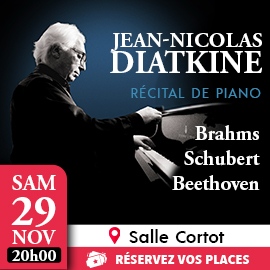Zu viel Hall, ein zu weiträumiger Klang: die Tontechnik hat mir die Freude an dieser CD gründlich vermasselt. Selbst in den langsamen Sätzen ist der Ton zu hallig und verwischt das musikalische Bild, in dem es manchmal schwierig ist, Chouchane Siranossians im Grunde doch so bezauberndes Geigenspiel zu genießen.
Wenn man sich sehr konzentriert und die Soli fokussiert, kommt der Charme dieses hoch sensiblen Spiels dennoch zur Geltung. In den schnellen Sätzen fasziniert die Virtuosität, die nie Selbstzweck ist und immer von feinster Differenzierung und herrlichen Verzierungen lebt. Aber selbst in den Capricen des Locatelli-Konzerts fehlt es mir an Intimität, die der Tonmeister dem initialen Spiel wohl genommen hat. Aber zumindest kommt in diesem Konzert doch eine Atmosphäre auf, die einen berührt. Um wievielt berührender das hinreißend inspiriert gespielte Largo geklungen hätte, wenn der Klang etwas trockener und konturierter gewesen wäre, kann man nur erahnen.
Auch in den Tartini- und Vivaldi-Konzerten kann man, immer auf Siranossians reichen Klang konzentriert, das Spiel der Solistin bewundern, die aus diesen Konzerten geigerisch und rhetorisch mehr herausholt als viele andere. Die Verve der schnellen Sätze und die Kontraste zwischen blendender Virtuosität und einer Zartheit, die einem den Atem raubt, zeigen, dass Chouchane Siranossian völlig Herrin über ihr Instrument ist und sich mit aller Leichtigkeit auf den Ausdruck der Musik konzentrieren kann. Die Auswahl der Stücke eröffnet ihr ungeahnte Möglichkeiten.
Schade, dass diese Qualitäten von der Akustik beeinträchtigt werden und dies unsere Gesamtbewertung schmälert. Vom Grave aus dem Tartini-Konzert würde ich trotz allem sagen, dass man es wohl nicht schöner und bewegender hören kann.
Too much reverb, a too spacious sound: the sound engineering thoroughly spoiled my enjoyment of this CD. Even in the slow movements the sound is too reverberant and blurs the musical picture in which it is sometimes difficult to enjoy Chouchane Siranossian’s basically so enchanting violin playing.
Nevertheless, if one concentrates hard and focuses on the solos, the charm of this highly sensitive playing comes to the fore. In the fast movements, the virtuosity is fascinating, never an end in itself, and always thriving on the finest differentiation and splendid ornamentation. But even in the caprices of the Locatelli concerto, I find a lack of intimacy, which the sound engineer must have taken away from the initial playing. But at least in this concerto there is an atmosphere that touches one. One can only guess how much more touching the ravishingly inspired Largo would have sounded if the sound had been a bit drier and more contoured.
In the Tartini and Vivaldi concertos, too, always focused on Siranossian’s rich sound, one can admire the soloist’s playing, which gets more out of these concertos violinistically and rhetorically than many others. The verve of the fast movements and the contrasts between dazzling virtuosity and a delicacy that takes one’s breath away show that Chouchane Siranossian is completely in command of her instrument and can concentrate with all ease on the expression of the music. The choice of pieces opens up unimagined possibilities for her.
It is a pity that these qualities are compromised by the acoustics which diminish our overall rating. Of the Grave from the Tartini concerto, I would defiantly say that it probably cannot be heard more beautifully and movingly.
https://www.pizzicato.lu/begluckt-verzucktes-schwarmen-und-atemanhalten/




















